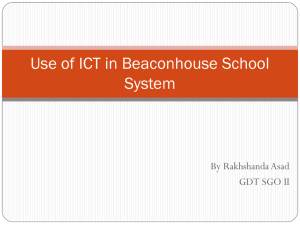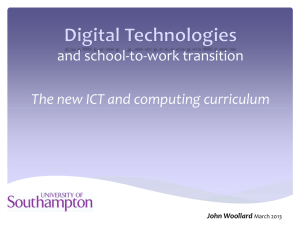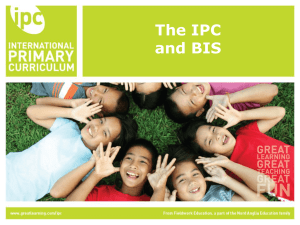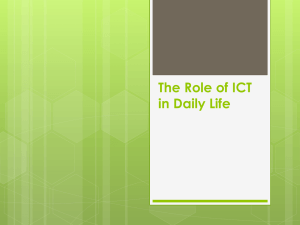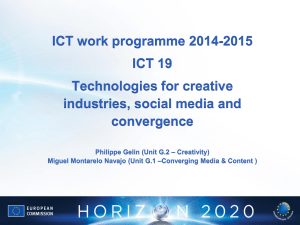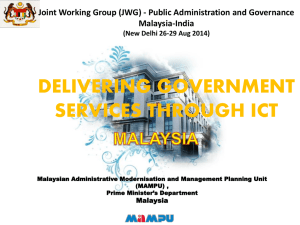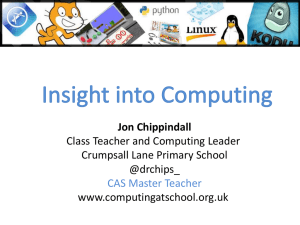Progress on the implementation of ICT in Education in South Africa
advertisement
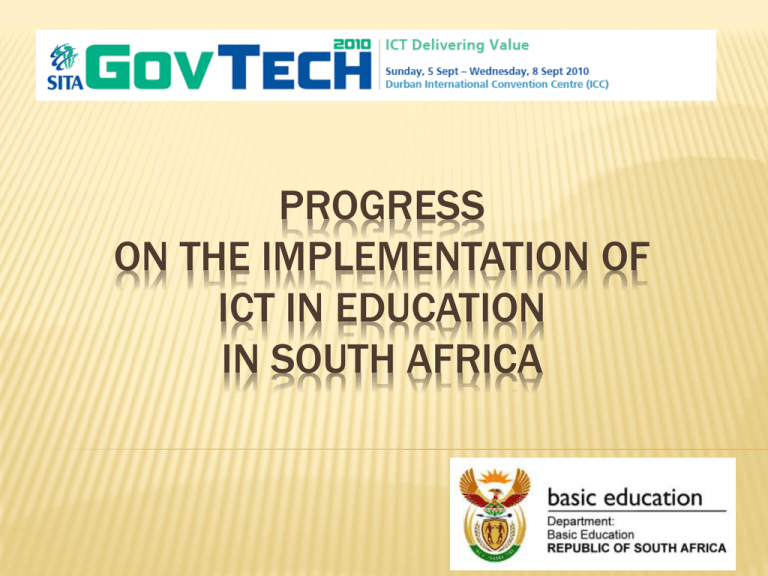
PROGRESS ON THE IMPLEMENTATION OF ICT IN EDUCATION IN SOUTH AFRICA “I think it's fair to say that personal computers have become the most empowering tool we've ever created. They're tools of communication, they're tools of creativity, and they can be shaped by their user.” Bill Gates INTRODUCTION Information and communications technologies (ICTs) play a significant role in today’s education and society (Surty, 2010). The past 15 years “in South Africa has been characterised by major transformation at all levels in the education system.” (Parker, 2006:59). The introduction of ICTs in education “represents an important part of Government's strategy to improve the quality of teaching and learning” and deliver lifelong learning “across the education and training system.” (White Paper on e-Education, DoE, 2004:19) CHALLENGES FOR EDUCATION Establish South Africa as an advanced Information Society Access, cost effectiveness and quality of education; and Integration of ICTs into the learning and teaching process E-EDUCATION GOAL “Every South African learner in the General and Further Education and Training bands will be ICT capable (that is, use ICT confidently and creatively to help develop the skills and knowledge they need to achieve personal goals and to be full participants in the global community) by 2013.” (Department of Education, 2004:17) STRATEGIC OBJECTIVES Infrastructure: To provide access to ICT infrastructure for administrative and teaching and learning purposes Professional development: Educators, managers & administrators knowledge, skills & support needed to integrate ICTs in teaching and learning Content: Software, electronic content & online learning resources Connectivity: To support an online learning environment Community Research & development: Explore various innovation in ICTs in education STATUS OF ICT INFRASTRUCTURE IN EDUCATION 7000 6000 Schools 5000 4000 3000 2000 1000 0 EC FS G KZN L M NW NC WC Schools 5929 1752 1880 5651 4243 1749 2115 421 1454 Administration 1232 941 1880 3200 918 1045 1428 281 1454 Teacher use 1232 793 1250 3200 918 1045 1428 60 1453 Teaching and Learning 1084 421 1250 100 303 508 1000 307 932 PROFESSIONAL DEVELOPMENT/ TEACHER SUPPORT Guidelines for Teacher Training and Professional Development in ICT (2007) Teacher Laptop Initiative CONTENT The Thutong Education Portal provides over 14,000 digital content resources, has 10000 registered users and averages 80,000 hits a month There are 84 learning spaces on the portal including a Support for Matric Space CONNECTIVITY Central to connectivity is the creation of a Virtual Private Network (VPN)for Education The VPN would be connected to schools by available last mile connectivity The VPN would provide an environment of educational resources (Thutong) and administrative purposes (SA-SAMS/LURITS/NEIMS) ICT IN SCHOOLS Computer literacy classes FET subjects IT and CAT Teaching & learning support resource SA-SAMS, e.g. administration & finance LURiTS ADMINISTRATION SA-SAMS South African School Administration and Management System Pat Bulling, Director of Education Management Systems “will provide the standard for all school data and school administration systems at ground level” (Gibson, 2009:18) LURITS Learner Unit Record Information And Tracking System Went live for first time in 2009 & still being rolled out across the country Expected to be fully populated by October 2010 Already, about 4-million learner records captured (30% of the information input) NEIMS National Education Infrastructure Management System Houses all the data about school infrastructure required for planning purposes, including e.g. number of classrooms, condition of buildings, water supply, type of electricity supply PROVINCES Gauteng (Online) 67% (1 493) of Gauteng’s 2 200 schools already have “access not only to computers, but to the wider world as well through Internet access.” (Gibson, 2009:46). “The Gauteng Online project, which was first conceived back in 2002, … aims to provide every school in the province with a computer laboratory, giving every learner in the public schooling system access to the Internet and to e-mail.” Free State 80% of FS’s 1550 schools linked to SA-SAMS Makes principals’ jobs easier, e.g. timetabling; puts their school on par with others Prov. dept. can watch learners’ & schools’ performance for trends & problems Western Cape (Khanya) 1136 schools have been helped to use technology effectively Another 118 schools are in various stages of preparation for the next wave of implementation A total of 43886 computers are used in Khanya schools (of these 27157 have been funded by Khanya or its donor partners, and the balance of 16729 have been procured by the schools themselves) 24970 Educators are being empowered to use technology optimally for curriculum delivery 823550 learners are already reaping the benefits of the project ICT IN THE CLASSROOM ICT “is one of the key things that we are committed to”. “We need to tap into the potential of ICT to maximise the work we are doing in education.” (Gibson, 2009:40) Proof of Concept Aims to demonstrate that it is possible to implement the ICT in Education initiative 1 unit of implementation per province Unit of implementation = geographically adjacent district/circuit(s) 135 – 200 schools per unit of implementation Carried out over a 3 year period, including planning & implementation stages All provinces involved, most in early planning stage; NW starting to implement ICT RESOURCE CENTRES IN SUPPORT OF THE POC ICT RESOURCE CENTRES IN POC DISTRICTS The ICT Resource Centre in the Mpumalanga province was launched on 1 June 2010 The ICT Resource Centre in the North West Province will be launched in October 2010 RESEARCH AND DEVELOPMENT MOBILE TECHNOLOGY USAGE High mobile telephony penetration rates in Africa Majority of population are Youth Emergence of undersea cables in Sub-Saharan Africa (Seacom, West Africa Cable System (WACS), and the EASSy Cable) MOBILE TECHNOLOGY USAGE 60.0 50.0 49.1 Percentage 40.0 30.0 27.4 20.8 20.0 16.9 11.8 10.0 0.0 Africa Americas Asia Europe Oceania Source: ITU World Telecommunication/ICT Indicators MOBILE TECHNOLOGY PROJECT Innovative application of mobile telephony to support teaching and learning Focusing mainly on Mathematics Promote sharing, collaboration, and exchange of learning resources and content MOBILE TECHNOLOGY Technology Architecture Learning management system Between 14:00 – 20:00 on Mondays to Thursdays learners can get online tutorial support from tutors Curriculum developed for Gr 10 Mathematics Developed by WebAlt Interface developed on Moodle platform Online support To be developed by Mindset Content hosting To be developed by DoE MXIT Technology used to deliver content (closed environment) Thutong Delivery Channel 1 Riitta Vänskä (Nokia) / Lucky Masilela (NSN) 10.09.2008 THANK YOU ICTs are not about the hardware… ….or the software… but about the WARM-ware Batho Pele! (People first) Mr. Edward Mosuwe Acting Deputy Director-General Department of Basic Education Tel: +27 (0) 12 357 4087 e-mail: mosuwe.e@dbe.gov.za


